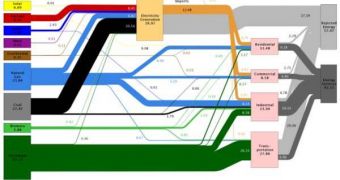Experts from the US Department of Energy's (DOE) Lawrence Livermore National Laboratory (LLNL) have recently released a new set of statistics, showing that the ratio of alternative energy to fossil fuels noticeably increased in 2008, as opposed to 2007. Wind farms, solar stations, geothermal plants and biofuels increased their presence in the average American home, the report also indicates. However, the consumption of geothermal energy remained roughly the same as the previous year, which is unfortunate, considering that this is, in fact, the most abundant renewable resource we have.
For the same time period, the average US household increased its natural gas consumption only slightly, whereas the use of coal and oil, the most polluting fossil fuels, has declined to some extent. The DOE estimates that 2008 saw the consumption of 99.2 quadrillion (quads) British Thermal Units (BTU) of energy, a decrease from 2007's 101.5 quadrillion BTU. Surprisingly, the industrial and transportation sectors exhibited reductions as well, of 1.17 and 0.9 quads, respectively. On the other hand, commercial and residential power consumption slightly climbed, showing people's trend of filling their houses with electronic devices.
The report speculates that the decrease in the two important sectors may have, to some extent, been triggered by the spike in oil prices, which was recorded in mid-2008. It could be that some factories and other enterprises found themselves unable to financially support purchasing new orders, and thus had to reduce the amounts of purchased petroleum. Another reason could be the rapid development of the biofuel sector, which saw a large expansion in 2008, as opposed to all previous years.
“This is a good snapshot of what's going on in the country. Some of the year-to-year changes in supply and consumption can be traced to factors such as the economy and energy policy,” LLNL Energy Systems Analyst A.J. Simon explains, quoted by ScienceDaily. The expert, together with colleagues, worked on developing the new energy flow charts, based on data provided to the laboratory by the DOE Energy Information Administration.
“I'm really excited about the renewed push for energy efficiency in this country. Because once that energy is rejected, it's no longer useful. But more efficient power plants, automobiles and even light bulbs really do reject less energy while providing the same energy services,” Simon says. The report also showed a slight increase in the output of nuclear power plants, from 8.41 quads in 2007 to 8.45 quads in 2008. This means that the plants have incentives to work more, and have less downtimes, the expert adds.

 14 DAY TRIAL //
14 DAY TRIAL //